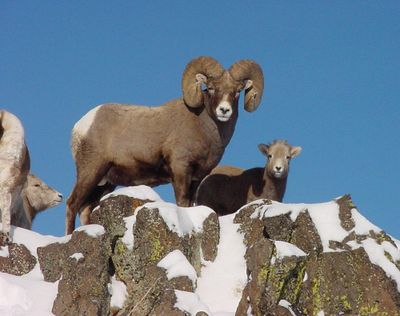Hard times hit area bighorns
Four Montana herds, two in Washington plagued by disease

Bighorn sheep, among the most prized big-game animals in the West, are being killed by the hundreds this winter in Western Montana in a desperate effort to contain a disease outbreak.
Washington is considering a similar last-ditch effort to curtail an outbreak that’s killing bighorns along the Yakima River between Ellensburg and Yakima.
As of Thursday, more than 200 pneumonia-plagued bighorns in the Missoula region had been shot by Montana Fish, Wildlife and Parks employees. Another 20-30 may have to be culled, said Mike Thompson, agency wildlife biologist in Missoula.
Outbreaks have been detected in four separate Missoula-region herds.
Nevada reports some bighorn herds are suffering a similar disease outbreak.
In Washington, about a dozen bighorns have been found dead since early December, but dozens more along the Yakima River are known to be infected with pathogens that are particularly virulent in bighorns.
“These same pathogens occur in domestic sheep with no effect, but they can eventually cause pneumonia wild sheep,” said Donny Martorello, state Fish and Wildlife Department special species manager.
The source of the outbreak has not been identified, he said.
Perhaps 60 percent of the bighorns are infected between Ellensburg and Yakima, he said.
“We could lose 20 percent of the bighorns to natural mortality and then suffer another four or five years of poor lamb recruitment,” he said. “The disease lingers in populations for many years. It’s a bad scenario.”
Department officials plan to decide this week whether they will kill obviously diseased bighorns. The pathogens are not harmful to humans, so the meat could be salvaged, he said.
“Two of the five bighorn herds in the Yakima region are affected, but we are very concerned about how it could spread. The Yakima region is home to about 800 of the 1,500 bighorns in Washington. This is a big deal.”
The disease is not new. “It crops up every now and then and we seem to be almost powerless against it,” Mortorello said.
Around 1995, a pneumonia outbreak along the Snake River killed about 300 bighorn sheep from Asotin upstream into Hells Canyon.
Idaho and Washington crews trapped 72 sick bighorns to prevent the spread of pneumonia. Despite intensive treatment in captivity by veterinarians and wildlife researchers, all but eight of those bighorns died by June 1996.
“There’s no vaccination to prevent this disease in bighorns, and there’s no treatment,” Mortorello said, adding that Washington State University wildlife pathologists have been studying the issue for years.
The disease outbreaks coincide with political issues involving bighorn sheep and livestock growers.
The Payette National Forest recently released a draft proposal for keeping domestic sheep from intermingling with wild bighorns. The plan was triggered by a lawsuit that charged the forest with failing to adequately protect wild sheep from the risk of contracting pneumonia from domestics.
The new proposals could reduce domestic sheep grazing in portions of the forest.
Meanwhile, Montana has just released a bighorn management plan that calls for more effort in keeping wild sheep away from domestic livestock.
“We need to do a better job of educating livestock producers, especially the small operations, about the dangers of disease transmission,” said Tom Carlsen, Montana FWP bighorn expert. “We’re looking at written agreements with livestock owners so they know exactly what to do when they find their sheep in contact with bighorns.”
Carlsen was in Reno, Nev., last week meeting with other bighorn experts at the Foundation for North American Wild Sheep annual convention. Montana, Idaho, Washington and other Western states and provinces offer bighorn ram hunting permits for auction at the convention to raise money earmarked for bighorn management.
Montana’s Rocky Mountain bighorn permit has sold for more than $300,000 in the past. Washington’s usually goes for about $60,000.
Most bighorn-hunting hopefuls compete in the long odds of drawing a one-in-a-lifetime tag in the state bighorn sheep permit lottery.
In Idaho, for example, fewer than 10 percent of resident applicants and fewer than 5 percent of nonresidents succeed in drawing one of the 85 or so permits offered each year.
Hunting permits for the affected areas of Montana and Washington surely will be reduced in drawings to be held this spring.
In rare cases, the Montana will authorize a livestock producer to kill a bighorn immediately if it approaches domestic sheep, Carlsen said.
“Luckily, most of our bighorn herds are away from grazing allotments,” he said.
But that’s no consolation for the bighorns being shot near Missoula.
“About 95 bighorns – nearly half the herd we have in the East Fork Bitterroot – would congregate on the lawns and school yards down in Bonner,” Thompson said. “That was a problem we were trying to address. That’s the focal point of the outbreak. We’ve had to remove virtually all of those sheep.”
Other outbreaks are occurring in the Rock Creek drainage, where the bighorns were doing so well that Montana was planning to trap and relocate some of the animals to Utah.
“That’s not going to happen now,” Thompson said, noting that sick animals are being culled in upper Rock Creek.
So far, Montana plans to let the disease run its course in two other herds as officials count on geographic barriers to contain it.
To make things worse, a clueless motorist recently killed eight bighorn sheep with his vehicle as they were attracted to a highway near Anaconda apparently to lick salt off the roadway.
“When it rains, it pours,” Thompson said.